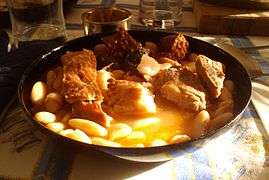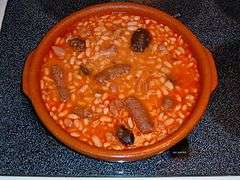Fabada asturiana
 Fabada Asturiana | |
| Alternative names | Fabada |
|---|---|
| Type | Stew |
| Course | Appetiser or main course |
| Place of origin | Spain |
| Region or state | Principality of Asturias |
| Serving temperature | Hot |
| Main ingredients | White beans |
| Variations | Olla podrida, cassoulet |
|
| |
Fabada asturiana, often simply known as fabada, is a rich Spanish bean stew, originally from and most commonly found in the autonomous community of Principality of Asturias, but widely available throughout the whole of Spain and in Spanish restaurants worldwide. Canned fabada is sold in most supermarkets across the country.
Fabada is a hot and heavy dish and for that reason is most commonly eaten during winter and at the largest meal of the day, lunch. It is usually served as a starter, but may also be the main course of the meal. It is typically served with crusty bread, and with Asturian cider or a red wine.
Ingredients
Fabada is made with dried large white beans (fabes de la Granja, soaked overnight before use), shoulder of pork (Lacón Gallego) or bacon (tocino), black pudding (morcilla), chorizo, and often saffron (azafrán).[1][2] Some recipes also call for longaniza.
Variations
The Spanish olla podrida and southern French cassoulet are both similar to fabada asturiana.
Images
 A prepared fabada
A prepared fabada Fabada prepared in a traditional clay cazuela
Fabada prepared in a traditional clay cazuela
See also
- Baked beans
- Cassoulet
- Common bean (Phaseolus vulgaris)
- Feijoada
- List of pork dishes
- List of stews
- Olla podrida
- Pork and beans
- Fabes con almejas (cookbook entry)
References
- References in Spanish Wikipedia
- Aris, Pepita. Spanish: Over 150 Mouthwatering Step-By-Step Recipes. London: Anness Publishing Ltd, 2003. p 203.
- Chandler, Jenny. The Food of Northern Spain. London: Pavilion Books, 2005. p 95.
- Klöcker, Harald. Culinaria Spain. Cologne: Könemann Verlagsgesellschaft mbH, 1998. p 208.